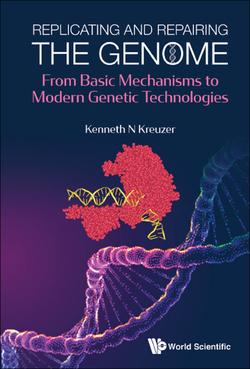Читать книгу Replicating And Repairing The Genome: From Basic Mechanisms To Modern Genetic Technologies - Kenneth N Kreuzer - Страница 42
На сайте Литреса книга снята с продажи.
4.2How do eukaryotic replication proteins compare to their prokaryotic counterparts?
ОглавлениеThe possible evolutionary relationships between replication proteins in the different domains of life have been probed by searching for amino-acid-sequence homologies and structural similarities. While one might expect a high level of conservation among proteins that are involved in such a vital process as DNA replication, the results are surprisingly mixed. A subset of replication proteins shows strong enough homology to support their assignment as orthologs evolved from the same ancestor. Others show structural similarities in spite of limited or no evidence of homology at the amino-acidsequence level. Yet other key replication proteins clearly belong to different protein families, ruling out any close evolutionary relationship. Not surprisingly, even when the proteins are from different families, the basic reactions are usually very similar. Archaeal species that have been studied to date have a set of replication proteins that are much more similar to those from eukaryotes than those from prokaryotes (but with a smaller number of proteins in archaeal replication than in eukaryotic replication).
Near the heart of the replisome, the most conserved protein between prokaryotes and eukaryotes is the clamp-loader complex. Very clear homology exists at the amino-acid-sequence level in the clamp-loader proteins, supporting their assignment as orthologs with a common ancestor. In addition, both complexes are heptameric and form the shape of a horseshoe (Figure 4.2A). Certain topoisomerases (Chapter 7) and enzymes in deoxynucleotide synthesis are also strongly conserved between prokaryotes and eukaryotes.
Figure 4.2.The conserved clamp loaders and sliding clamps. Clamp loaders from a bacterial virus, archaea, E. coli and eukaryotes are schematized, with protein names indicated (panel A). Crystal structures of sliding clamps from these same organisms are compared in panel B. The two leftward images show the entire clamp with 90° rotation between the two. The next image shows superpositions of the domains that are present six times in each sliding clamp (notice how similar these are between the domains from the various organisms). The rightward images show space-filling models, with positively (blue) and negatively (red) charged regions indicated; note that the central cavity is lined with positively charged residues in each case, allowing DNA (with its negatively charged backbone) to slide freely. The sliding-clamp structures in panel B are as follows: E. coli, PDB ID 2POL; bacteriophage T4, PDB ID 1CZD; Pyrococcus furiosus, PDB ID 1GE8; S. cerevisiae, PDB ID 1PLQ; human, PDB ID 1AXC (see http://www.rcsb.org for all structures). The panels in this figure were reproduced from Hedglin et al. (2013), with permission from Cold Spring Harbor Laboratory Press.
The clamp itself provides an interesting evolutionary case. The clamps of prokaryotes and eukaryotes show relatively weak aminoacid-sequence homology and are thought to be fairly distant homologs on this basis. The donut-like structures of the prokaryotic and eukaryotic clamps are strikingly similar, each containing six very similar domains that circle around the central hole (Figure 4.2B). Surprisingly, however, the prokaryotic clamp is composed of two identical subunits each with three domains, while the eukaryotic clamp is composed of three identical subunits each with two domains.
Other key proteins in DNA replication have obvious structural similarity but seem to be quite distant from each other in evolution. A case in point involves initiator proteins that bind origins of replication, which will be discussed in Chapter 5. Initiator proteins of both prokaryotes and eukaryotes have a prominent ATPase domain from a particular evolutionary group of ATPase modules, but the prokaryotic and eukaryotic ATPase domains are not particularly close relatives. Considering the initiator proteins of bacteria and that of S. cerevisiae, they also share the feature of a C-terminal DNA-binding domain linked to the ATPase domain. These DNA-binding domains are entirely different structures and are not related, although both bind (different) specific sequences within duplex DNA.
A similar story arises with the replicative helicases. Both the prokaryotic and eukaryotic replicative helicases are hexameric enzymes with a hole in the middle for DNA, and so their morphology is similar. However, the ATPase subunits that make up the hexamer are from different families in prokaryotes versus eukaryotes, and so these helicases are clearly not orthologs. Interestingly, in spite of their similar function at the fork, the inherent mechanism of these two helicases differs, as does their pathway of loading (see below).
The two enzymes that actually synthesize nucleic acid at the fork, DNA polymerase and RNA primase, might be expected to be the most highly conserved. They are not. While nearly all DNA polymerases share an architecture resembling a right hand, with the active site in the palm, multiple families of DNA polymerase are found throughout the three domains of life. The main replicative polymerase in bacteria, discussed in Chapter 3, is from an entirely different family than the replicative polymerases of eukaryotes. Likewise, the primases of prokaryotes and eukaryotes are from completely different families and unrelated to each other.
These examples beg the question of how replication machineries evolved from those of our earliest ancestors. There is some speculation that viral DNA-replication machineries may have been co-opted at some point in evolution for cellular replication, to explain the cases where the proteins are not orthologous between the domains of life. In spite of these complex evolutionary relationships, the central reactions in DNA replication are quite highly conserved with few exceptions. Thus, the central steps in eukaryotic replication, described in this Chapter, will be very familiar from the discussion of prokaryotic replication in Chapters 2 and 3.
